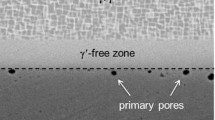Abstract
A Model was developed for the finite-difference calculation of carburization profiles in high-temperature alloys. The method includes the ternary crossdiffusion effect due to substitutional alloying elements that are preferentially oxidized. It can be used to treat cases such as carburization of preoxidized alloys or simultaneous oxidation and carburization. Up to three distinct types of carbide precipitation reactions can be included in the calculations. The solubility product is computed for each reaction and the amount of C that reacts is removed from the diffusion process. The model can treat two sets of boundary conditions corresponding to the presence or absence of a protective oxide scale. For comparison, under protective conditions carburization profiles were obtained for preoxidized alloys using C14 radioactive tracer. The application of the model yields values for the diffusivities of C in the alloys tested. Under nonprotective conditions, the predictions of the model were compared to carburization profiles reported for pack carburization tests. The method is able to predict maximum carbide levels and penetration depths for different alloys in various conditions and can be used in the selection and design of high-temperature alloys for use in carburizing environments.
Similar content being viewed by others
References
J. I. Goldstein and A. E. Moren,Metall. Trans. 9A, 1515 (1978).
D. Farkas and J. Delgado,Scripta Met. 17, 261 (1983).
S. Mrowec and T. Werber, Chap. 4 inGas Corrosion of Metals (National Bureau of Standards, Washington, D.C., 1978).
D. Coates,Metall. Trans. 3, 1203 (1976).
J. S. Kirkaldy,Can. Metall. Q. 8, 35 (1969).
E. K. Ohriner and J. E. Morral,Scr. Metall. 13, 7 (1979).
G. Roberts,Met. Sci. 13, 94 (1979).
O. Bohm and M. Kalweit,Acta Metall. 12, 641 (1964).
K. Bongartz, D. F. Lupton, and H. Schuster,Metall. Trans. 11A, 1883 (1980).
K. E. Blazek and J. R. Cost,Trans. JIM,17, 630 (1976).
A. H. Eltoukhy and J. E. Greene,J. Appl. Phys. 51, 4444 (1980).
C. Brown and J. S. Kirkaldy,Trans. Am. Inst. Min. Metall. Pet. Eng. 230, 223 (1964).
A. R. Mitchell, Chap. 2Computational Methods in Partial Differential Equations (Wiley, New York 1976).
K. Ohla, I. Wolf, and H. J. Grabke, to be published.
T. Wada,Metall. Trans. 11A, 1076 (1980).
T. Hirano, M. Okada, H. Araki, T. Noda, H. Yoshida, and R. Watanabe,Metall. Trans. 12A, 451 (1981).
G. H. Meier, W. C. Coons, and R. A. Perkins,Oxid. Met. 17, 235 (1982).
O. Demel,Radex Rundsch. 2, 201 (1977).
R. A. Perkins and P. T. Carlson,Metall. Trans. 5, 1511 (1974).
R. P. Agrarwala, M. C. Naik, M. S. Arnand, and A. R. Paul,J. Nucl. Mater. 36, 41 (1970).
W. Steinkusch,Werkst. Korros. 30, 837 (1979).
A. W. Bowen and G. W. Leak,Metall. Trans,1, 1695 (1970).
M. A. Krishtal and A. M. Morova,Fiz. Tekhn. Nauk,1, 93 (1967).
W. Batz, H. W. Mead, and C. E. Birchenall,J. Met. 4, 1070 (1952).
R. J. Borg and D. Y. F. Lai,J. Appl. Phys. 41, 5193 (1970).
H. V. Mirami and P. Maaskant,Phys. Status. Solids,A14, 521 (1972).
K. Ledjeff, A. Rahmel, and M. Schorr,Werkst. Korros. 31, 83 (1980).
R. O. Williams,Metall. Trans. 13A, 959 (1982).
T. Takahashi, J. Fujiwara, T. Matsushima, M. Kiyokawa, I. Marimoto, and T. Watanabe,Trans. Iron Steel Inst. Jpn. 18, 221 (1978).
O. Kubaschewski and C. B. Alock,Metallurgical Thermochemistry Pergamon Press, New York, 1979.
T. Wada, H. Wada, J. F. Elliot, and J. Chipman,Metall. Trans. 2, 2199 (1971).
V. I. Alekseev and M. Parnis,Dokl. Akad. Nauk SSSR,224, 922 (1975).
T. Nishizawa and B. Uhrenius,Scand. J. Metall. 6, 67 (1977).
M. Small and E. Ryba,Metall. Trans. 12A, 1389 (1981).
I. Tomilin,Zh. Fiz. Kim. 588 (1968).
K. Natessan and F. Kasner,Metall. Trans. 4, 2557 (1973).
F. N. Mazandarany and R. D. Pehlke,Metall. Trans. 4, 2067 (1973).
Author information
Authors and Affiliations
Rights and permissions
About this article
Cite this article
Farkas, D., Ohla, K. Modeling of diffusion processes during carburization of alloys. Oxid Met 19, 99–115 (1983). https://doi.org/10.1007/BF01225978
Received:
Revised:
Issue Date:
DOI: https://doi.org/10.1007/BF01225978




